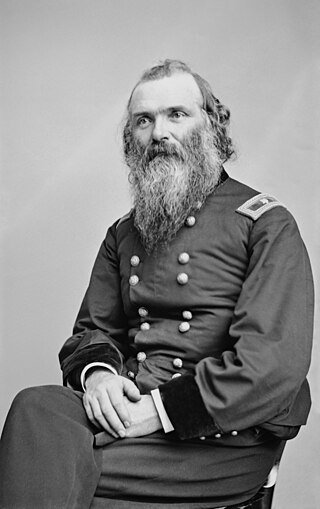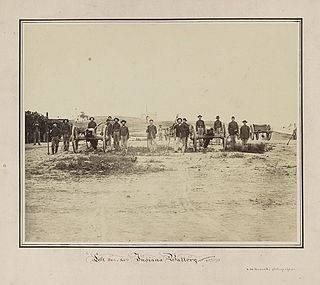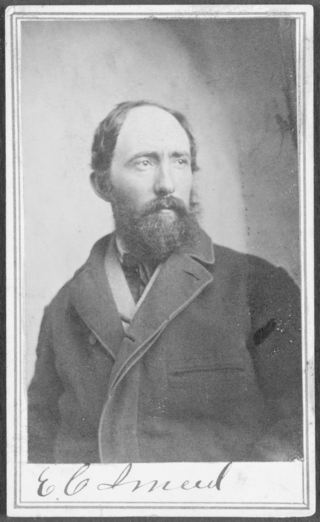
Daniel Craig McCallum was a Scottish-born American railroad engineer, general manager of the New York and Erie Railroad and Union Brevet Major General of the United States Military Railroads during the American Civil War, known as one of the early pioneers of management. He set down a group of general principles of management, and is credited for having developed the first modern organizational chart.

Herman Haupt was an American civil engineer and railroad construction engineer and executive. As a Union Army General during the American Civil War, he revolutionized U.S. military transportation, particularly the use of railroads.

The U.S. Military Railroad (USMRR) was established by the United States War Department as a separate agency to operate any rail lines seized by the government during the American Civil War. An Act of Congress of 31 January 1862 authorized President Abraham Lincoln to seize control of the railroads and telegraph for military use in January 1862. In practice, however, the USMRR restricted its authority to Southern rail lines captured in the course of the war. As a separate organization for rail transportation the USMRR is one of the predecessors of the modern United States Army Transportation Corps.
The 13th Michigan Infantry Regiment was an infantry regiment that served in the Union Army during the American Civil War.

The 21st Michigan Infantry Regiment was an infantry regiment that served in the Union Army during the American Civil War.

The 51st Indiana Infantry Regiment was an infantry regiment that served in the Union Army during the American Civil War.

General Adna Anderson was chief engineer of the Northern Pacific Railroad from 1880 to 1888. He first worked in railways in 1847, and worked his way up through various railways, leading to being an assistant engineer for the Army of the Potomac during the Civil War. Near the end of the war, he was placed in charge of all government railways. He returned to private industry in 1867, eventually leading to employment with Northern Pacific Railroad in 1881. There, he led construction of railways connecting St. Paul with both Portland and Seattle. He was vice president of the company from 1886 until leaving in 1888. After leaving Northern Pacific, he worked in an office in New York City for another year, where he shot himself on May 14, 1889. He died the next day.
The 58th Regiment Indiana Infantry was an infantry regiment that served in the Union Army during the American Civil War.
The 73rd Regiment Indiana Infantry was an infantry regiment that served in the Union Army during the American Civil War.
Battery "I" 4th Regiment of Artillery was a light artillery battery that served in the Union Army during the American Civil War.
Battery E, 1st Ohio Light Artillery was an artillery battery that served in the Union Army during the American Civil War.

The 18th Ohio Infantry Regiment was an infantry regiment in the Union Army during the American Civil War.
The 37th Regiment Indiana Infantry was an infantry regiment that served in the Union Army during the American Civil War.

The 5th Tennessee Cavalry Regiment was a cavalry regiment that served in the Union Army during the American Civil War. This regiment was originally recruited as the 1st Middle Tennessee Cavalry.
Battery A, 1st Battalion Tennessee Light Artillery was an artillery battery that served in the Union Army during the American Civil War. It was also known as Company A, 1st Middle Tennessee Battery.

The 1st Tennessee Cavalry Regiment was a cavalry regiment that served in the Union Army during the American Civil War. It was also known as 1st East Tennessee Cavalry. The regiment was organized and was nominally commanded by Robert Johnson, the second son of Tennessee politician and Southern Unionist Andrew Johnson, but in truth the regimental commander was James P. Brownlow, the second son of Parson Brownlow.

20th Indiana Battery Light Artillery was an artillery battery that served in the Union Army during the American Civil War.

William Wierman Wright was a well known nineteenth century American railroad engineer and civil engineer. He was born in York Springs, Pennsylvania.

Eben Cedron Smeed was an American civil engineer who was best known for his work on railroads, particularly the United States Military Railroad (USMRR) in supporting Sherman's Atlanta and Savannah campaigns working first under General Herman Haupt and then Colonel William Wierman Wright. Smeed typified the successful, self-made civil engineer in the 19th century.












